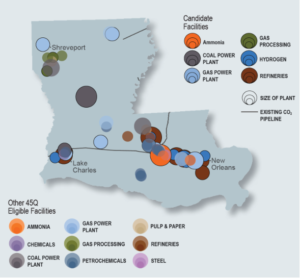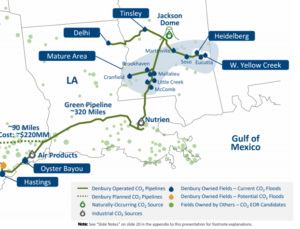Residents of and visitors to the Gulf states have to face the facts: Carbon capture and storage is not a viable climate solution. The focus must turn to renewable, regenerative solutions that uphold environmental justice and reduce emissions now.
In the face of mounting public pressure to reduce the emissions driving the climate crisis, talk in Louisiana has turned to carbon capture and storage (CCS) as a purported solution. This brief highlights the risks and concerns of CCS.[1]
“Carbon Capture and Storage” refers to processes designed to collect or “capture” carbon dioxide generated by industrial processes — such as coal-, oil-, and gas-fired power production or plastics manufacturing – and then transport those captured emissions to sites where they are used or stored underground.
Concern 1: CCS is not a climate solution.
Carbon capture and storage is expensive, energy-intensive, and unproven at scale, and it does not reduce carbon in the atmosphere. CCS technology entrenches reliance on fossil fuels rather than accelerating the needed transition to cheaper and cleaner renewable energy. Of particular importance to targeted communities in Louisiana, the technology also poses environmental, safety, and health risks.
Adding carbon capture to coal- or gas-fired power plants makes them more expensive, less efficient, and less competitive than renewable energy projects, which are already the cheapest source of electricity for most of the country and most of the world. Nearly 80% of captured carbon is just being used to produce more oil.
Concern 2: Louisiana is a target for CCS development.
Louisiana has been widely touted as a potential epicenter for industrial carbon capture and storage development in the United States. Existing concentrations of oil, gas, and petrochemical infrastructure make Louisiana attractive to proponents of CCS.
Supporters pushed a CCS-friendly regulatory program through the Louisiana legislature in 2009. Current law places responsibility for regulating carbon dioxide injection, storage, and use with the Department of Natural Resources, an agency known for protecting instead of regulating the industry.
[Facilities potentially eligible for 45Q CCS tax credits. Source: Regional Carbon Capture Deployment Initiative]
Concern 3: Residents will pay the costs for CCS.
Massive tax subsidies will be required to implement carbon capture and storage, and the costs of construction are significantly higher than renewable energy and storage options.
Proponents claim that there is already pipeline infrastructure available for transportation and injection of CO2 in these areas along the Gulf. However, these pipelines would have to be repurposed — and therefore reconstructed — to accommodate transport of compressed carbon dioxide, placing additional burdens on land, water, and communities, at a hefty cost that local ratepayers would likely bear.[2]
CCS would also threaten Louisiana’s wetlands. The wells and pipelines would contribute to land loss, directly contradicting the Governor’s Executive Order for state agencies to adhere to the Coastal Master Plan.
Because carbon capture infrastructure would be built near emitting sites, facilities would further harm the same people already overburdened by industrial pollution. In Louisiana, that would put Black, Brown, and Indigenous communities at even greater risk.
[Source: Denbury, Inc.]
Concern 4: Carbon pipelines are dangerous.
Piping CO2 through communities presents a dangerous threat to health and safety. To transport CO2 through pipelines, it must be highly pressurized and kept very cold, which would require the construction of pipelines that can withstand those conditions. Condensed CO2 can be corrosive to the steel used to build those pipelines, increasing the risk of leaks, ruptures, and potentially catastrophic running fractures.[3] In addition, explosive decompression of a CO2 pipeline releases more gas, more quickly, than an equivalent explosion in a gas pipeline, because of the intense pressures involved.[4]
As the Intergovernmental Panel on Climate Change has recognized, “carbon dioxide leaking from a pipeline forms a potential physiological hazard for humans and animals.”[5] In areas closest to pipelines, released CO2 could quickly drop temperatures to -80°F, coating the surrounding area with super-cold dry ice.[6] At high concentrations, CO2 is a toxic gas that can restrict breathing. Potential contaminants in CO2 streams, like hydrogen sulfide (H2S), can dramatically compound these risks.
Residents of Yazoo County, Mississippi, learned this in 2020 when a Denbury Enterprises CO2 pipeline ruptured. Three hundred people were evacuated, and 45 people had to be hospitalized, including some sickened individuals whom authorities found near the scene acting like ‘zombies’.
Concern 5: CCS focuses on the wrong thing.
Carbon capture allows industries to keep burning fossil fuels. Even worse, the vast majority of captured carbon today is used to produce more oil through so-called “enhanced oil recovery.”Real solutions for climate change in Louisiana do exist, supported by local communities. The focus of Louisiana leaders and policymakers should remain on cost-effective strategies that maximize public benefit and ensure a stable and safe economic future for Louisiana and its people. Carbon capture and storage does not fit that bill.
[1] Dismukes, D et al., Integrated Carbon Capture and Storage in the Louisiana Chemical Corridor, LSU (Feb 18, 2019)
[2] See Dismukes et al. at 79.
[3][3] See Dismukes et al. at 182.
[4] Mahgerefteh, H. & Denton, G. & Rykov, Y. Pressurised CO2 pipeline rupture. Institution of Chemical Engineers Symposium Series (2008), at 869-879.
[5] IPCC Special Report on Carbon Dioxide Capture and Storage, Chapter 4: Transport of CO2 (2005), at 181.
[6] See Mahgerefteh et al. at 10.
This blog was posted on 06/25/2021.


